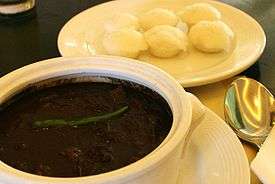Dinuguan
 A bowl of dinuguan and a plate of puto | |
| Alternative names | Pork blood stew, blood pudding stew |
|---|---|
| Course | Main course |
| Place of origin | Philippines |
| Serving temperature | Hot |
| Main ingredients | Pork offal, pig's blood, vinegar, garlic, siling mahaba |
Dinuguan is a Filipino savory stew of pork offal (typically lungs, kidneys, intestines, ears, heart and snout) and/or meat simmered in a rich, spicy dark gravy of pig blood, garlic, chili (most often siling mahaba), and vinegar.[1]
Etymology and names
The most popular term dinuguan and other regional naming variants come from their respective word for "blood" (e.g. "dugo" in Tagalog means "blood" hence "dinuguan" as "to be stewed with blood"). Possible English translations include pork blood stew or blood pudding stew.[2]
Dinuguan is also called sinugaok in Batangas, zinagan in Ibanag, twik in Itawis, tid-tad in Kapampangan, dinardaraan in Ilocano, dugo-dugo in Cebuano, rugodugo in Waray, sampayna or champayna in Northern Mindanao and tinumis in Bulacan and Nueva Ecija. Another name for dinuguan is "chocolate meat".
Description
This dish is rather similar to Tiết canh of Vietnam, European-style blood sausage, or British and Irish black pudding in a saucy stew form.[3] It is perhaps closer in appearance and preparation to the Polish soup Czernina or an even more ancient Spartan dish known as melas zomos (black soup) whose primary ingredients were pork, vinegar and blood.
Dinuguan can also be served without using any offal, using only choice cuts of pork. In Batangas, this version is known as sinungaok. It can also be made from beef and chicken meat, the latter being known as dinuguang manok ('chicken dinuguan').[3][4] Dinuguan is usually served with white rice or a Philippine rice cake called puto.[3] The Northern Luzon versions of the dish namely the Ilocano dinardaraan and the Ibanag zinagan are often drier with toppings of deep-fried pork intestine cracklings. The Itawis of Cagayan also have a pork-based version that has larger meat chunks and more fat, which they call twik.
The most important ingredient of Dinuguan recipe is obviously the pig's (pork) blood. Pork blood is used in many other Asian cuisines either as coagulated blood acting as a meat extender or as a mixture for the broth itself. Pork Dinuguan is the latter.[4][5]
Vegetarian version
A vegetarian version is known as "beanuguan" and is made of red beans, tofu, onions, garlic, and vinegar. The red beans are cooked, mashed with water or vegetable stock added, then drained to remove the skin. Sometimes cornflour is added to thicken the liquid, so the consistency mimics coagulated blood.
- Dinuguan
- Serkele (Baliuag special Dinuguan)
- Special Baliuag, Bulacan dinuguan (in bread)
- Dinuguan in SM City Baliwag food contest
See also
References
| Wikibooks Cookbook has a recipe/module on |
- ↑ Margarita Marquis (2007). La Cuisine des Philippines (in French). Editions Publibook. ISBN 978-2-7483-3506-4.
- ↑ Emily Ignacio (2005). Building diaspora: Filipino community formation on the Internet. Rutgers University Press. ISBN 978-0-8135-3514-2.
- 1 2 3 Alan Davidson & Tom Jaine (2006). The Oxford companion to food. Oxford University Press. ISBN 978-0-19-280681-9.
- 1 2 "Dinuguan a la Ate Angelina". MarketManila. July 26, 2006.
- ↑ "Easy Pork Dinuguan Recipe". RecipeniJuan. November 11, 2016.